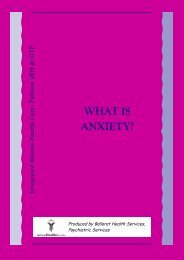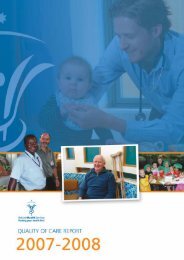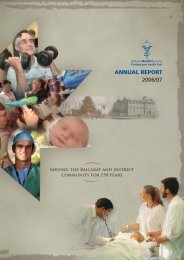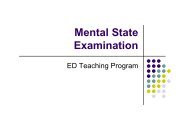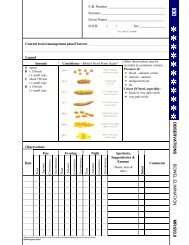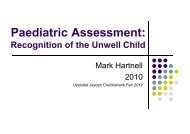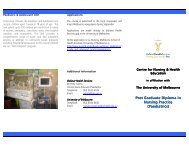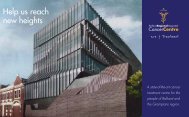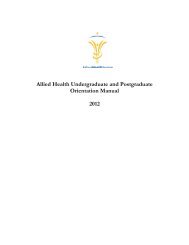ED lecture series - BHS Education Resource - Ballarat Health Services
ED lecture series - BHS Education Resource - Ballarat Health Services
ED lecture series - BHS Education Resource - Ballarat Health Services
Create successful ePaper yourself
Turn your PDF publications into a flip-book with our unique Google optimized e-Paper software.
Emergency DepartmentHMO Lecture SeriesSelf-Directed Learning Package2013/2014To be read in conjunction with:HMO/intern position description<strong>ED</strong> HMO Handbook<strong>ED</strong> self directed workbook & education timetablesPage 1 of 19
Emergency Department <strong>Education</strong> ProgramThe <strong>ED</strong> provides a <strong>series</strong> of tutorials on Thursday mornings for Hospital Medical Officers, withmedical students occasionally attending.Given that medical staff rotate to the <strong>ED</strong> it is impossible to coordinate a schedule of sessionsthat matches well with these rotations for various individuals. It is also true that during a tenweek <strong>ED</strong> rotation that a session scheduled in Week 10 is of little use when you are seeing thepatients in the early part of your rotation.Therefore in 2012 we will provide the <strong>ED</strong> sessions and teaching materials in advance. There area number of pre reading materials including journal articles and web links. Training resources,such as pre-reading materials, PowerPoint presentations and relevant articles are available onthe <strong>ED</strong> <strong>Education</strong> <strong>Resource</strong>s - HMOs page on the <strong>ED</strong> Intranet Site (only accessible at <strong>BHS</strong>).In combination with the self directed workbook the aim of providing these in advance is formedical staff to assess their prior knowledge, and work at their own pace to improve theirknowledge of Emergency Medicine.Hopefully this will involve a substantial amount of case based learning, both in the educationroom and while working in the <strong>ED</strong>.<strong>BHS</strong> Online <strong>Education</strong>al <strong>Resource</strong>http://educationresource.bhs.org.au/An online education resource has been complied to allow doctors, nursing and clinicalstaff access to education programs, presentations and other relevant information whennot within the <strong>BHS</strong> facility.Under the Emergency icon, this site contains the HMO education program informationincluding recommend pre reading, PowerPoint presentation and other learningresources.http://educationresource.bhs.org.au/emergencyPage 2 of 19
Emergency Medicine Certificate (EMC)The EMC is a 6 month training program offered though the Australasian College forEmergency Medicine (ACEM). The course will provide participants with a broad range ofknowledge and skills to meet the demands of basic emergency medicine practice. Itfocuses on competencies considered essential for a non-specialist doctor working inEmergency Medicine.ACEM website: http://www.acem.org.au/home.aspx?docId=1EMC Information for Candidates documentThe certificate is open to candidates who are PGY 2 and have completed at least 10 weeks (at1FTE) experience in an Emergency Department.These media releases give some background to the program:Media release from the Prime MinisterMedia release from ACEMACEM registrar training – accreditedRegistrarsThis workbook is to be reviewed by the <strong>ED</strong> Registrars to ensure they are aware of thetraining and education provided to junior medical staff who they supervise overnight.Page 3 of 19
1. ResuscitationAndrew Tongs is the <strong>BHS</strong> resuscitation educator. He has a defined role in providingtraining and assessments for medical staff. This is particularly important for all medicalstaff that work in critical care and/or are a member of the MET or code blue teams. Wehave provided his pre reading materials. These are considered mandatory pre readingfor the Emergency registrars, and ICU registrars and medical registrars.<strong>Education</strong> sessions will be run face to face with simulation sessions, and these are ofvalue if the didactic components of teaching are replaced by pre reading andpreparation by professional and committed medical staff.<strong>BHS</strong> <strong>Education</strong> resourcesThe pre reading is located on the website:1. ALS Algorithm 2012 presentation2. ALS drugs 2012 presentation3. Defibrillation and pacing 2012 presentation4. Paediatric ALS 2012 presentationOrgan and Tissue DonationIn the case of clinical triggers for donation being activated ring the intensivist on dutyand/or Joanna Forteath, the <strong>BHS</strong> nurse donation specialist, on 0411 323 006. If thefamily raises organ donation, answer questions if trained to do so, otherwise refer tothe organ donation specialists.Presentation of organ donation and clinical triggers.Australian resuscitation council resources:ARC basic life supportARC adult cardiorespiratory arrestARC chokingARC Paediatric ALS 2011ARC neonatal flowchartALSBLS competency assessment tool 2011 v4Page 4 of 19
2. Major TraumaLearning objectives1. To be familiar with <strong>BHS</strong> protocols for trauma including trauma teams2. Management of suspected cervical spine injuries3. To understand the Victorian State Trauma System and how role of <strong>Ballarat</strong><strong>Health</strong> <strong>Services</strong> in that system.Pre readingHughes T & Cruickshank J. Adult Emergency Medicine at a Glance. Chichester,West Sussex, UK : John Wiley & Sons, 2011. Chapter 8 Trauma; primary survey.Chapter 9 Trauma; secondary survey. Chapter 10 Major head and neck injury.Chapter 11 Minor head & neck injury<strong>BHS</strong> <strong>Education</strong>al resourcesPowerPoint presentations;1. Trauma Overview2. Trauma clinical skills workshop slides3. Trauma scenarios4. Trauma basic self-directed tutorial5. The massive transfusion protocolOther learning resourcesMajor trauma advice and inter-hospital transfer guidelineshttp://www.health.vic.gov.au/trauma/links.htmhttp://www.health.vic.gov.au/trauma/triage.htmPage 5 of 19
3. Cardiology - Chest Pain & SyncopeThe cardiology session will examine contrasting clinical cases of chest pain that may be due topotentially lethal causes such as myocardial infarction or more benign causes such ascostochondritis. Important features in the history that help discriminate different causes ofdyspnea will be discussed along with appropriate initial investigations.Learning objectives1. To name the common and important medical conditions that cause chest pain and theircharacteristic features on history.2. To rapidly diagnose and manage acute myocardial infarction3. To interpret ECGs in myocardial ischaemia and arrhythmias.4. To name the common and important medical conditions that cause syncope and theircharacteristic features on history and exam.Pre readingHughes T & Cruickshank J. Adult Emergency Medicine at a Glance. Chichester, WestSussex, UK : John Wiley & Sons, 2011. Chapter 21 Slow heart rate. Chapter 32 Fast heartrate. Chapter 34 Chest pain: cardiovascular. Chapter 35 Chest pain: non cardiovascularGuidelines for the management of acute coronary syndromesAddendum to guidelines for the management of acute coronary syndromes<strong>BHS</strong> <strong>Education</strong> resourcesPowerPoint presentations;1. Chest pain in the <strong>ED</strong>2. Syncope in the <strong>ED</strong>3. Syncope case <strong>series</strong>Other learning resources<strong>BHS</strong> STEMI pathway - <strong>ED</strong> presentation – July 2012Guide for assessing cardiac patients - Evolving risk stratification: Heart Foundation ACStreatment algorithmMJA consensus guidelines: http://www.mja.com.au/journal/guidelinesCruickshank J. Initial Management of Cardiac Arrhythmias. Vol 37, (&) 516-520 2008Australian Family Physician.Short QT Syndrome (SQTS)Page 6 of 19
4. Respiratory – dyspnea: asthma, pneumonia &pulmonary embolismThe respiratory session will examine contrasting clinical cases of dyspnea that will illustrate theprinciples of diagnostic reasoning. Important physical findings that help discriminate differentcauses of dyspnea will be discussed along with appropriate initial investigations.Learning objectives1. Be able to describe the differences and similarities in the medical history, physicalexamination and investigations of common or life threatening causes of dyspnea.2. To manage asthma and pneumonia using best practice guidelines3. To be able to use the Wells score & PERC rule in diagnosis of PEPre readingHughes T & Cruickshank J. Adult Emergency Medicine at a Glance. Chichester,West Sussex, UK : John Wiley & Sons, 2011. Chapter 36 Shortness of breath.Chapter 7 Blood gas analysis.<strong>BHS</strong> <strong>Education</strong> resourcesPowerPoint presentations;1. Respiratory dyspnea presentation2. Respiratory case <strong>series</strong> 13. Respiratory case <strong>series</strong> 24. A classic respiratory caseOther learning resourcesWell’s Criteria for Pulmonary Embolismo Wells et al. Excluding pulmonary embolism at the bedside withoutdiagnostic imaging: management of patients with suspected pulmonaryembolism presenting to the emergency department by using a simpleclinical model and d-dimer. Ann Intern Med. 2001 Jul 17;135(2):98-107.http://www.ncbi.nlm.nih.gov/pubmed/11453709National Asthma Council: Written asthma action plans.MDCalc Mobile PSI/PORT Score: Pneumonia Severity Index for Adult CAPPage 7 of 19
5. Neurology: Headache and Stroke, Seizures &dizziness.The neurology session will examine contrasting clinical cases of headache, seizures and dizzinessthat may be due to potentially lethal causes such as subarachnoid haemorrhage or more benigncauses such as migraine. Important features in the history include establishing the timing ofonset of symptoms and using eye witnesses.Learning objectives1. Understand the key differential diagnoses for headache2. Understand use of ABCD 2 and ROSIER tools for TIA and stroke3. Develop your diagnostic strategy for dizziness.4. Develop your approach to seizuresPre readingPage 8 of 19Hughes T & Cruickshank J. Adult Emergency Medicine at a Glance. Chichester, WestSussex, UK : John Wiley & Sons, 2011. Chapter 41 Headache. Chapter 42 Stroke &Transient Ischaemic Attack. Chapter 43 Seizures.<strong>BHS</strong> <strong>Education</strong> resourcesPowerPoint presentations;1. Headache2. Seizures3. DizzinessSelf-directed tutorials1. Lumbar puncture2. Acute migraneOther learning resourcesDealing with Dizziness by Dr Mark Paine from Australian Prescriber 2005 28/4. pg 94-97Chronic Migranous Vertigo by John Waterston Journal of clinical Neuroscience 2004,11/4 pg 384-388Migraine review http://emedicine.medscape.com/article/1142556-overviewTension headache review http://emedicine.medscape.com/article/792384-overviewHeadache in children http://emedicine.medscape.com/article/802158-overview
Page 9 of 19Vertigo and Dizziness Tintinalli http://www.slideserve.com/jane/vertigo-and-dizzinessch-231-tintinalli
6. ToxicologyIn this session we will look at toxicology issues relating to deliberate self-harm. Otherrelevant information relating to self-harm can be found in the psychiatric topic.Learning objectives1. To comprehensively assess a patient presenting with overdose including common drugssuch as paracetamol2. To provide supportive care and definitive care (e.g. antidotes)3. To manage toxicology presentations in the <strong>ED</strong>, including access to off site resourcesPre readingHughes T & Cruickshank J. Adult Emergency Medicine at a Glance. Chichester,West Sussex, UK : John Wiley & Sons, 2011. Chapter 24 Toxicology generalprinciples. Chapter 25 Toxicology: specific poisons.<strong>BHS</strong> <strong>Education</strong> resourcesPowerPoint Presentations;1. Paracetamol toxicity2. Snakebite case <strong>series</strong>Other learning resources - SnakebiteHow to treat snakebite from www.australiandoctor.com.au (free for APHRA reg.doctors)Antivenom update from Australian PrescriberCase based discussion on snake bite authored by Dilhani Dona as part of theACEM Certificate Emergency MedicineOther learning resources - PoisoningSafe prescribing of opioids for persistent non cancer pain by MichaelMcDonough. Australian Prescriber Vol35 : No 1 : February 2012Guidelines for management of paracetamol poisoningTreatment Approaches for Users of Methamphetamine – A practical guide forfrontline workersManagement of Patients with Physcostimulant ToxicityPage 10 of 19
7. Psychiatry, violence & aggression.In these sessions we will use contrasting case studies of patients who have disturbed orchallenging behaviours to explore how the medical interview, physical examination andinvestigations are used to determine a diagnosis (or differential diagnosis). An emphasis will beplaced on performing a mental status examination in addition to the general examination. Acompassionate approach and establishing rapport will be discussed.Learning objectives1. To recognise the need to perform a mental state examination to comprehensivelyassess a patient presenting with disturbed behaviour;2. To recognize there are many organic causes of “psychiatric” presentationsPre readingHughes T & Cruickshank J. Adult Emergency Medicine at a Glance. Chichester,West Sussex, UK : John Wiley & Sons, 2011. Chapter 24 Toxicology generalprinciples. Chapter 25 Toxicology: specific poisons. Chapter 26 Psychiatry. Selfharm and capacity. Chapter 27 Psychiatry: the disturbed patient.<strong>BHS</strong> <strong>Education</strong> resourcesPowerPoint presentation: Mental state examination and psychiatric certificationOther PowerPoint presentations available on the <strong>BHS</strong> intranet (access onlyavailable within in <strong>BHS</strong> facility);1. Violence in <strong>ED</strong>2. Psychiatric certification3. Mental health4. Mental state examinationBehavioral Emergencies from life in the FastlaneOther learning resourcesManaging aggressive and violent patients. Fulde et al Australian Prescriber 118 |Volume 34 | NUMBER 4 | AUGUST 2011 ArticlesSafe prescribing of opioids for persistent non cancer pain. Michael McDonoughAustralian Prescriber Vol35 : No. 1 : February 2012Page 11 of 19
8. Surgery – Abdominal pain, back pain & renal colicA systematic approach to evaluating the clinical findings leads to an appropriate differentialdiagnosis and the ability to formulate an appropriate management plan. It is important toexclude life threatening conditions, remember common things occur commonly, andnon specific abdominal pain is common in young people.Learning objectives1. To appreciate the importance of a framework for a systematic approach to decisionmakingin the assessment of abdominal pain,2. To appreciate that every patient does not need a CT or ultrasound.3. To understand the most important decision for a surgeon to make is the need for anoperation (see point 2)4. To appreciate that decision making is different in elderly patientsPre readingHughes T & Cruickshank J. Adult Emergency Medicine at a Glance. Chichester, WestSussex, UK : John Wiley & Sons, 2011. Chapter 19 Abdominal pain. Chapter 20 Urologyproblems. Chapter 40 Gastroenterology.<strong>BHS</strong> <strong>Education</strong> resourcesPowerPoint presentation;1. Abdominal PainOther learning resourcesAbdominal Pain in Elderly Persons http://emedicine.medscape.com/article/776663-overviewTsipouras S Non abdominal causes of abdominal pain. Australian Family Physician Vol.37, No. 8, August 2008 http://www.racgp.org.au/afp/200808/200808tsipouras.pdfPage 12 of 19
9. Minor trauma and OrthopaedicsIn these sessions we will use case studies of patients who have presented to the <strong>ED</strong> including aradiology library. We are seeking help from HMOs to add to this library. Please email the nameand UR number to jaycenc@bhs.org.auLearning objectivesA systematic approach to assessment of injuriesInterpretation of radiographs in <strong>ED</strong>/orthopaedicsAppropriate referral to fracture clinic using BOSSNET e-form and use of <strong>BHS</strong>guideline for diagnosis of scaphoid fractures.Pre readingHughes T & Cruickshank J. Adult Emergency Medicine at a Glance. Chichester,West Sussex, UK : John Wiley & Sons, 2011. Chapter 12 Wounds. Chapter 14Hand injuries. Chapter 15 Wrist and forearm injuries. Chapter 16 Shoulder andelbow injuries. Chapter 17 Back pain, hip and knee injuries. Chapter 18 Tibia,ankle and foot injuries.<strong>BHS</strong> <strong>Education</strong> resourcesPowerPoint Presentation; Scaphoid fractureOther PowerPoint Presentations available on the <strong>BHS</strong> intranet (access onlyavailable within in <strong>BHS</strong> facility);1. Lower Limb injuries2. Hand injury summary3. Blunt head injury in children4. Orthopaedic cases – Self-directed workbookOther learning resourcesChildhood Fracture Management – RCH clinical guidelines and facts sheetShoulder reduction techniques http://shoulderdislocation.net/videosPage 13 of 19
In the last few years the Emergency Department at <strong>Ballarat</strong> <strong>Health</strong> <strong>Services</strong> conductedseveral research projects on scaphoid fractures and in particular the role of early CT. Wehave published literature validating our clinical practice guideline.The following journal articles on scaphoid fractures were conducted in the EmergencyDepartment at <strong>Ballarat</strong> <strong>Health</strong> <strong>Services</strong>. They are available directly and on a websiteauthored by Jaycen Cruickshank - www.scaphoidfracture.com.auScaphoid fractures - EMAScaphoid fractures - CT in a CPG - Western Journal of Emergency MedicinePage 14 of 19
10. Obstetrics and GynaecologyIn these sessions we will use contrasting case studies of patients who have presented to the <strong>ED</strong>and had a final diagnosis of ectopic pregnancy, miscarriage, and threatened miscarriage. TheDepartment of <strong>Health</strong> though Western <strong>Health</strong> has developed a DVD Precious 10 which isrecommended viewing for all emergency clinicians. The video is located in the <strong>ED</strong> administrationoffice.Learning objectives1. To use a diagnostic approach that does not miss ectopic pregnancy2. To manage women with bleeding in early pregnancy in an appropriate andcompassionate way.3. To understand appropriate use of β HCG and ultrasound, including consent for transvaginalultrasound.4. To manage hyperemesis gravidarum safelyPre readingHughes T & Cruickshank J. Adult Emergency Medicine at a Glance. Chichester, WestSussex, UK : John Wiley & Sons, 2011. Chapter 23 Obstetrics and Gynaecology problems.<strong>BHS</strong> <strong>Education</strong> resourcesPowerPoint presentation; Bleeding in Early pregnancyOther learning resourcesDHS - Western <strong>Health</strong> video Precious 10Australian Red Cross: Anti-D Guidelines, and Important information for Rh(D)negative womenChris Feier, Clinical Emergency Medicine Algorithms: Vaginal Bleeding in EarlyPregnancy (Less than 20 weeks) West J Emerg Med. 2008 January; 9(1): 47–51.Page 15 of 19
11. Sepsis and infectious diseasesLearning objectives1. To recognize severe sepsis and understand early treatment plans.2. Febrile neutropenia guidelines include early antibiotic administration3. To understand importance of early recognition and treatment of meningococcaldiseasePre readingHughes T & Cruickshank J. Adult Emergency Medicine at a Glance. Chichester,West Sussex, UK : John Wiley & Sons, 2011. Chapter 38 Sepsis. Chapter 3Shock and intravenous fluids.<strong>BHS</strong> <strong>Education</strong> resourcesPowerPoint presentations;1. <strong>BHS</strong> <strong>ED</strong> Sepsis talk2. Sepsis Presentation from NSW <strong>Health</strong>Other learning resourcesSepsis toolkit from the NSW Government<strong>Education</strong>al video available for purchase regarding meningococcal diseasefrom http://www.meningococcal.org/a. A Preview: Managing Menigococcal Disease:http://www.youtube.com/watch?v=ZUUcWWjjlhQPage 16 of 19
12. Paediatrics in the <strong>ED</strong>.Learning objectives1. To recognize the seriously ill child2. To manage appropriately common paediatric emergencies, including paediatriconcology issues3. To manage paediatric oncology patients in consultation with our paediatric unit4. To develop a safe patient centred approach to paediatric analgesia and sedationPre readingMiall Rudolf & Smith Paediatrics at a Glance. 3 rd edition Chichester, West Sussex,UK : Wiley-Blackwell, 2012.<strong>BHS</strong> <strong>Education</strong> resourcesPowerPoint presentations;1. Assessment of the sick child2. Paediatric casesOther learning resourcesThe Royal Children’s clinical guidelines are an excellent resource to look up whileworking in the Emergency Department.Childhood fracture Management – RCH clinical guidelines, demonstration videos,x-ray examples and fact sheets.EZ IO (Interosseous Needle) Instructions from Brad SobolewskiThe Nightmare Neonate: Life threating Events in the First month of LifeThe Critically Ill or Comatose Infant: An Organised ApproachPage 17 of 19
13. Eyes, Ear Nose Throat, & Dental.Learning objectives1. To manage common eye conditions, including removal of foreign body2. To recognize and refer serious eye conditions3. To learn some recognition and management of some common and seriousdental emergencies and appropriate referral strategies4. Additional training for E.N.T presentationsPre reading• Hughes T & Cruickshank J. Adult Emergency Medicine at a Glance. Chichester,West Sussex, UK : John Wiley & Sons, 2011. Chapter 21 Ear, nose, throat anddental problems. Chapter 22 Eye problems.<strong>BHS</strong> <strong>Education</strong> resourcesContent to comeOther PowerPoint Presentations available on the <strong>BHS</strong> intranet (access onlyavailable within in <strong>BHS</strong> facility);1. Eye VAQs2. Red Eye3. ENT Foreign bodies4. Dental EmergenciesOther learning resourcesAntibiotic Therapeutic Guidelines (eTG Complete via Clinicians <strong>Health</strong> Channel) –Eye infections, oral and dental infections, respiratory tract infections: otheroThese are VERY helpful as a guide when NOT to use antibiotics andcontain excellent management and patient information resources.Page 18 of 19
14. Medical EmergenciesLearning objectives1. Oncology – to manage febrile neutropenia correctly2. To identify and manage diabetic emergencies3. To refer appropriately to the medical registrar4. To manage back pain presentationsPre readingHughes T & Cruickshank J. Adult Emergency Medicine at a Glance. Chichester,West Sussex, UK : John Wiley & Sons, 2011. Chapter 29 Loss of function andindependence. Chapter 39 Endocrine emergencies.<strong>BHS</strong> <strong>Education</strong> resourcesPowerPoint presentation; Thoracic and lumbar back painOther learning resourcesAustralian Prescriber – information about drugs and therapeutics published by NPSMedicineWiseBurns Management GuidelinesGood anticoagulant practice from NPS MedicineWisehttp://www.scaphoidfracture.net.au/Page 19 of 19



